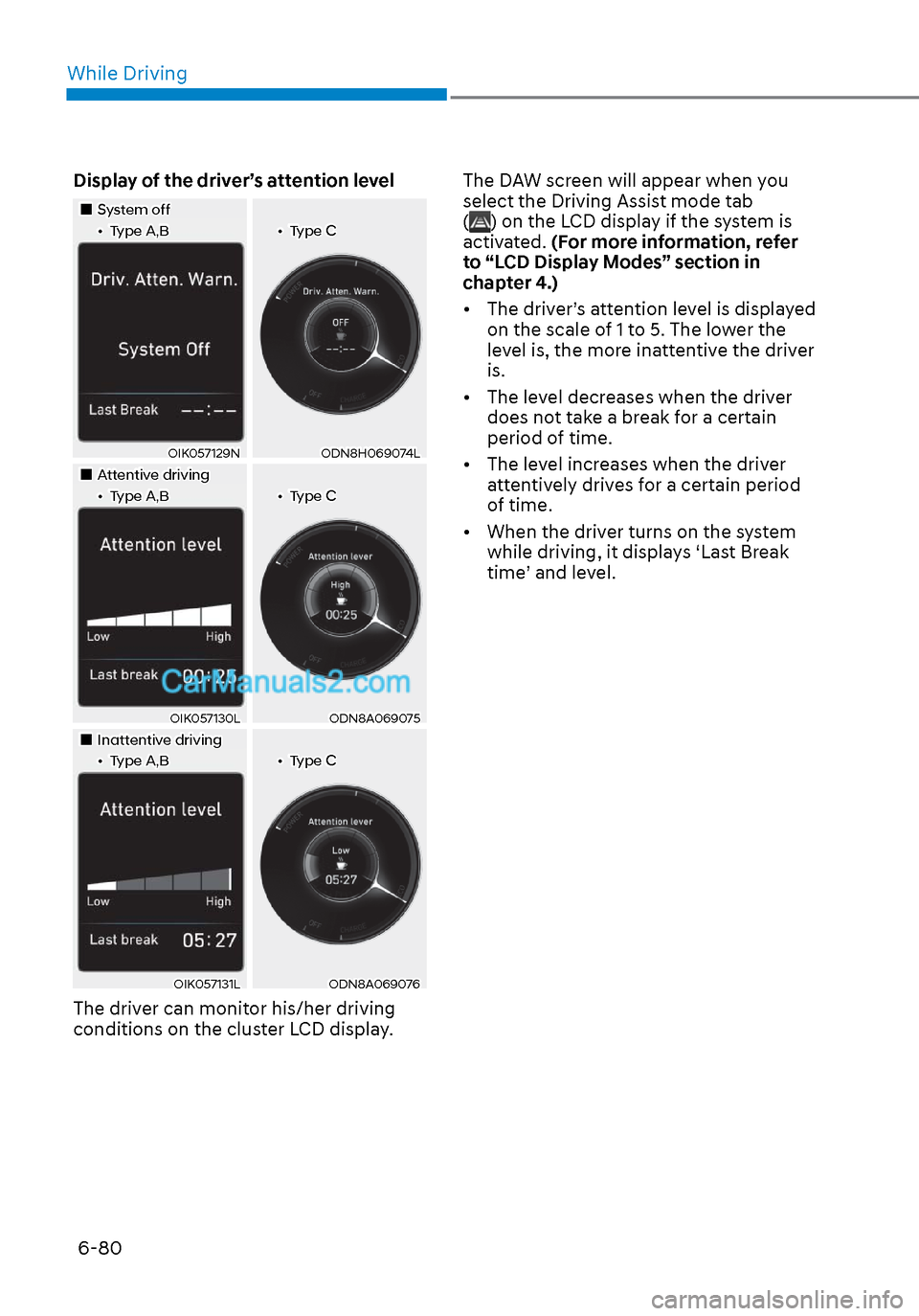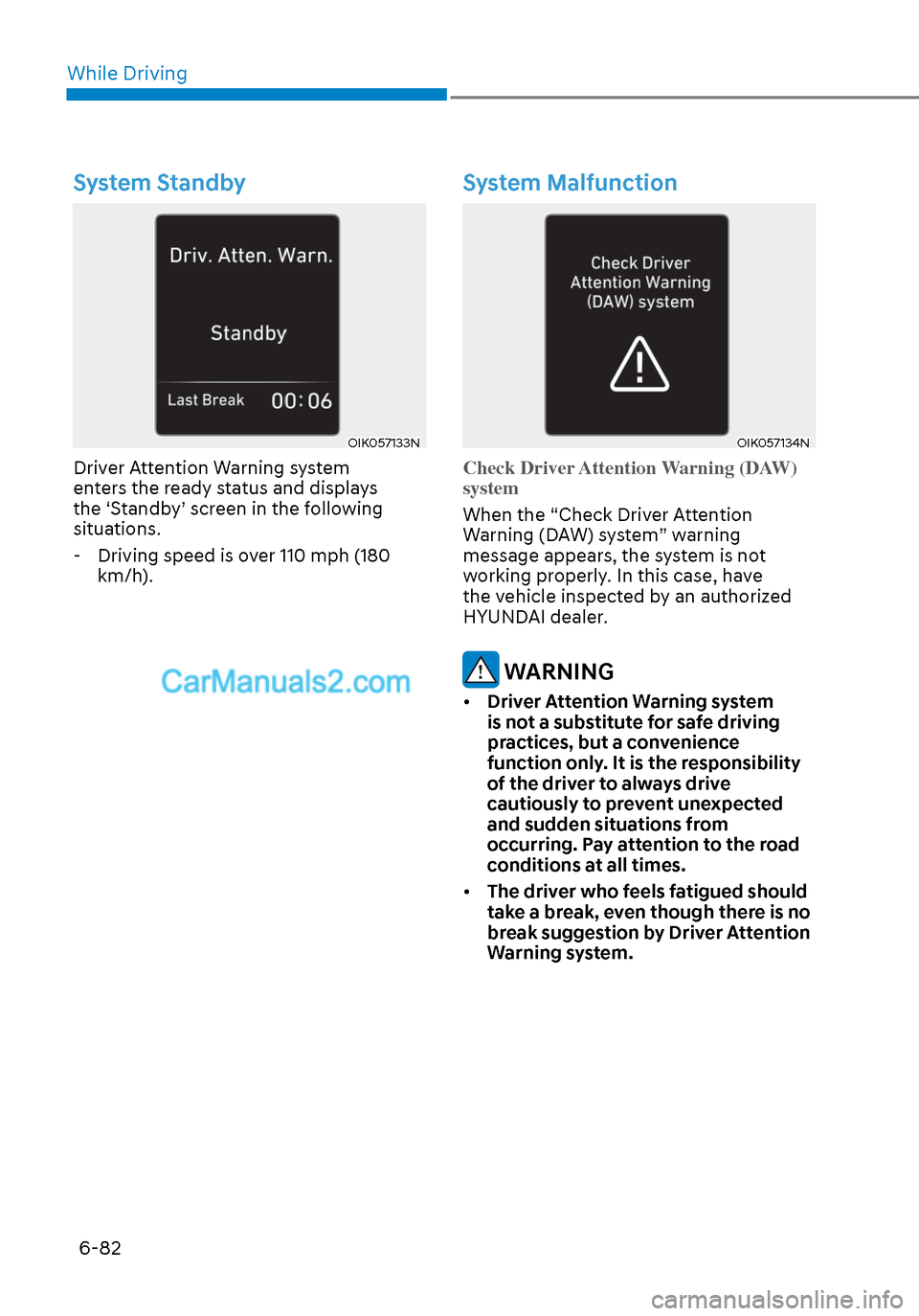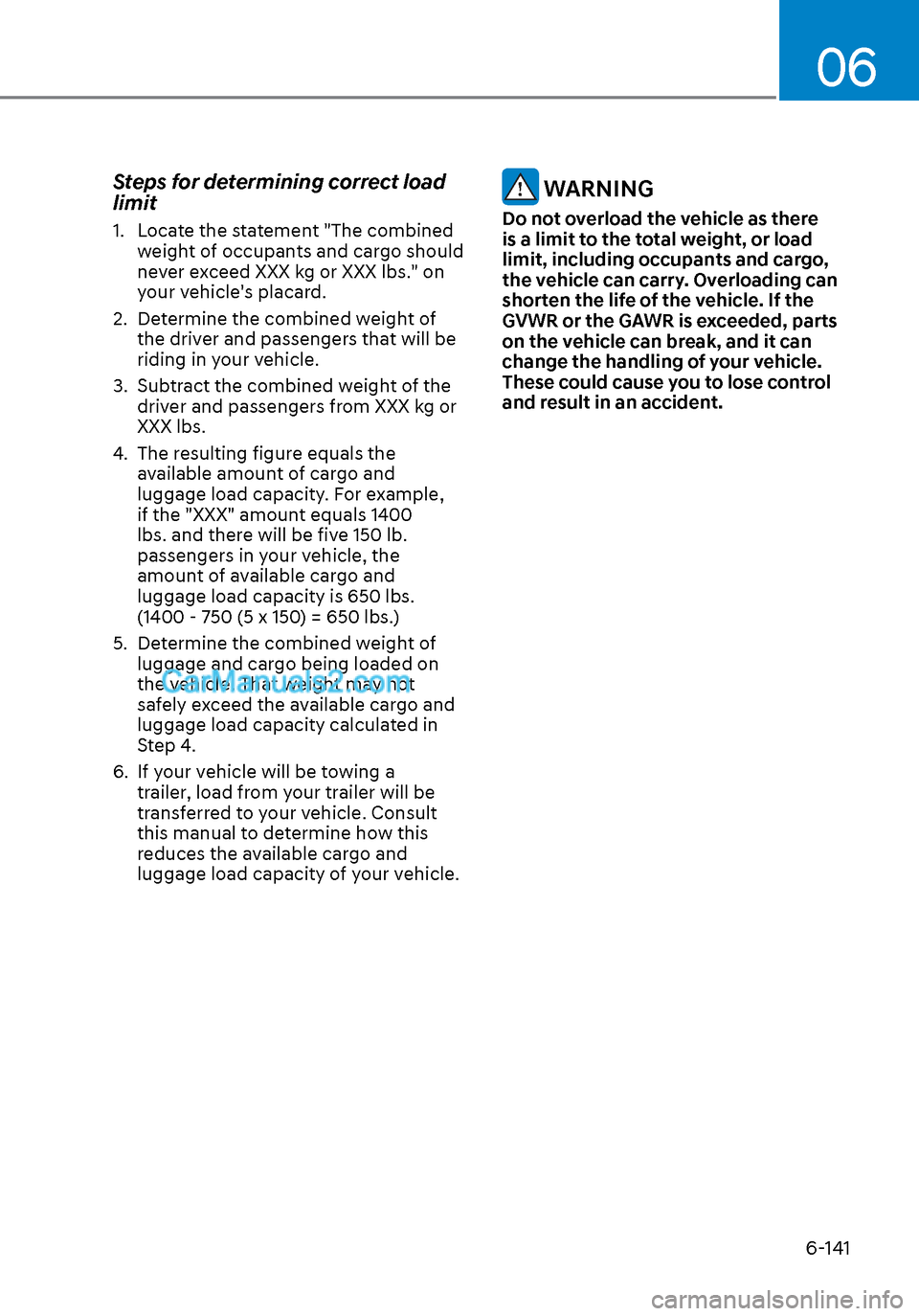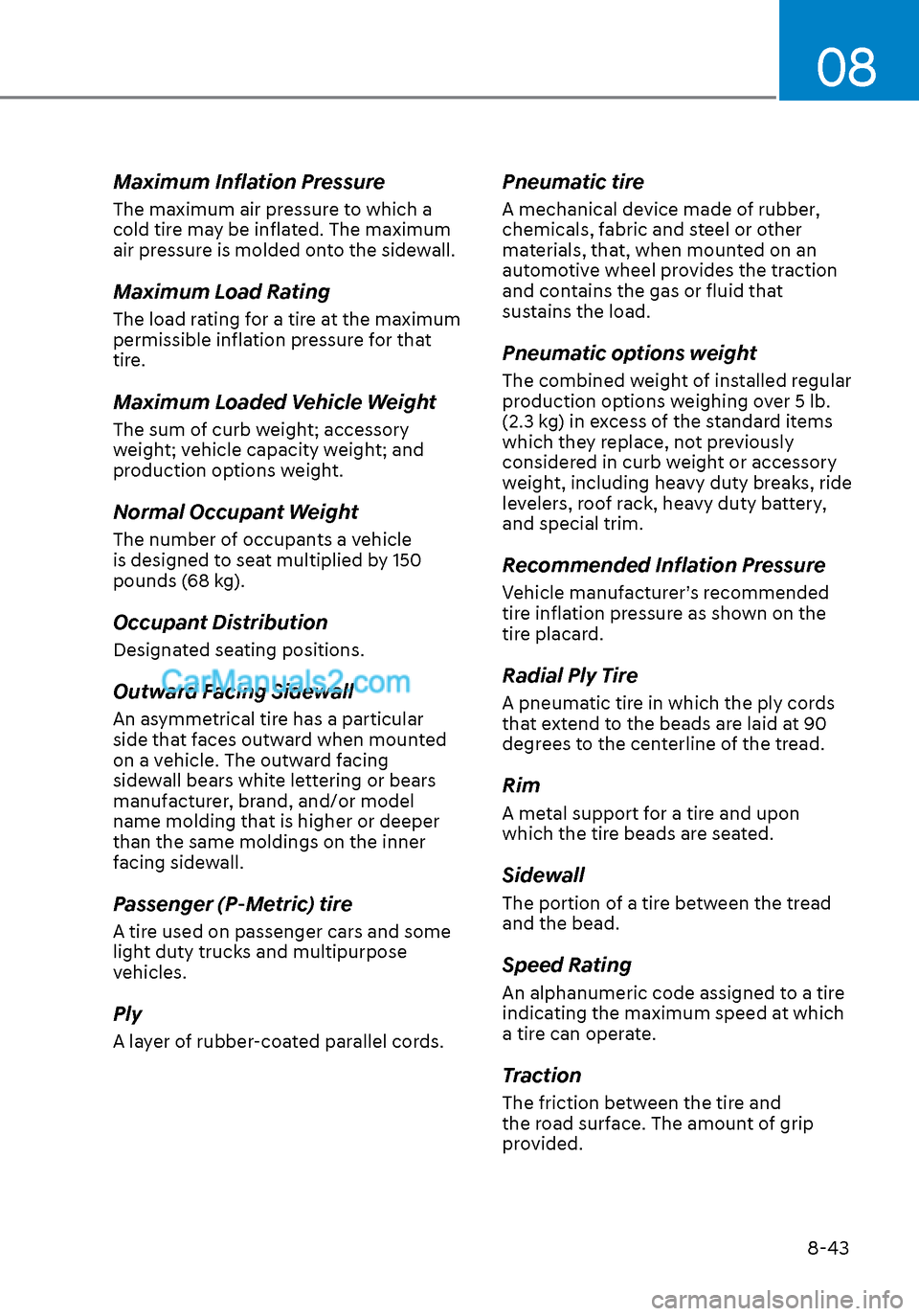2020 Hyundai Sonata Break
[x] Cancel search: BreakPage 364 of 537

While Driving6-80
Display of the driver’s attention level
System offSystem off••Type A,BType A,B••Type CType C
OIK057129NOIK057129NODN8H069074LODN8H069074L
Attentive drivingAttentive driving••Type A,BType A,B••Type CType C
OIK057130LOIK057130LODN8A069075ODN8A069075
Inattentive drivingInattentive driving••Type A,BType A,B••Type CType C
OIK057131LOIK057131LODN8A069076ODN8A069076
The driver can monitor his/her driving
conditions on the cluster LCD display. The DAW screen will appear when you
select the Driving Assist mode tab
(
) on the LCD display if the system is
activated. (For more information, refer
to “LCD Display Modes” section in
chapter 4.)
• The driver’s attention level is displayed on the scale of 1 to 5. The lower the
level is, the more inattentive the driver
is.
• The level decreases when the driver does not take a break for a certain
period of time.
• The level increases when the driver attentively drives for a certain period
of time.
• When the driver turns on the system while driving, it displays ‘Last Break
time’ and level.
Page 365 of 537

06
6-81
Take a break
OOSH069090LOOSH069090L
• The “Consider taking a break” message appears on the cluster LCD
display and a warning sounds to
suggest that the driver take a break,
when the driver’s attention level is
below 1.
• Driver Attention Warning system will not suggest a break, when the
total driving time is shorter than 10
minutes.
• System will not suggest a break, if "Consider taking a break" message
appears within 10 minutes.
• Depending on the driver's driving style and habits, system can be suggest to
rest even when driver is not tired.
CAUTION
If any other warning sound such as
seat belt warning chime is already
generated, Driver Attention Warning
system warning may not sound.
Resetting the System
• The last break time is set to 00:00 and the driver’s attention level is set to 5
(very attentive) when the driver resets
Driver Attention Warning system.
• Driver Attention Warning system resets the last break time to 00:00
and the driver’s attention level to 5 in
the following situations.
- The engine is turned OFF.
- The driver unfastens the seat belt
and then opens the driver’s door.
- The vehicle is stopped for more than 10 minutes.
• Driver Attention Warning system operates again, when the driver
restarts driving.
Page 366 of 537

While Driving6-82
System Standby
OIK057133NOIK057133N
Driver Attention Warning system
enters the ready status and displays
the ‘Standby’ screen in the following
situations. - Driving speed is over 110 mph (180 km/h).
System Malfunction
OIK057134NOIK057134N
Check Driver Attention Warning (DAW)
system
When the “Check Driver Attention
W
arning (DAW) system” warning
message appears, the system is not
working properly. In this case, have
the vehicle inspected by an authorized
HYUNDAI dealer.
WARNING
• Driver Attention Warning system
is not a substitute for safe driving
practices, but a convenience
function only. It is the responsibility
of the driver to always drive
cautiously to prevent unexpected
and sudden situations from
occurring. Pay attention to the road
conditions at all times.
• The driver who feels fatigued should
take a break, even though there is no
break suggestion by Driver Attention
Warning system.
Page 367 of 537

06
6-83
Information
The system may suggest a break according
to the driver’s driving pattern or habits
even if the driver doesn’t feel fatigue.
NOTICE
• Driver Attention Warning system
utilizes the camera sensor on the
front windshield for its operation. To
keep the camera sensor in the best
condition, you should observe the
followings:
• Never install any accessories or
stickers on the front windshield, or
tint the front windshield.
• NEVER place any reflective objects
(i.e. white paper, mirror) over the
dashboard. Any light reflection
may cause a malfunction of Driver
Attention Warning system.
• Pay extreme caution to keep the
camera sensor dry.
• Never disassemble the camera
assembly, or apply any impact on the
camera assembly.
If the sensor is forcibly moved out
of proper alignment, the system
may not operate correctly. Have the
vehicle inspected by an authorized
HYUNDAI dealer.
CAUTION
• Driver Attention Warning system may
not provide alerts in the following
situations:
• Driver Attention Warning system
is using the front view camera. To
optimize the function of the front
view camera, the driver should
manage carefully. For detailed
information, please refer to the
warning statements in Lane Keeping
Assist system section.
• The lane detection performance
is limited. (For more information,
refer to “Lane Keeping Assist (LKA)”
section in this chapter.)
• The vehicle is erratically driven
or is abruptly turned for obstacle
avoidance (e.g. construction area,
other vehicles, fallen objects, bumpy
road).
• Forward drivability of the vehicle is
severely undermined (possibly due
to wide variation in tire pressures,
uneven tire wear-out, toe-in/toe-out
alignment).
• The vehicle is driven on a curvy road.
• The vehicle is driven through a windy
area.
• The vehicle is driven on a bumpy
road.
• The vehicle is controlled by the
following driving assist systems:
- Forward Collision-Avoidance Assist
system
- Lane Keeping Assist system
- Smart Cruise Control system
- Lane Following Assist system
CAUTION
Playing the vehicle audio system at
high volume may prevent occupants
from hearing Driver Attention Warning
system warning sounds.
Page 425 of 537

06
6-141
Steps for determining correct load
limit
1. Locate the statement "The combined weight of occupants and cargo should
never exceed XXX kg or XXX lbs." on
your vehicle's placard.
2. Determine the combined weight of the driver and passengers that will be
riding in your vehicle.
3. Subtract the combined weight of the driver and passengers from XXX kg or
XXX lbs.
4. The resulting figure equals the available amount of cargo and
luggage load capacity. For example,
if the "XXX" amount equals 1400
lbs. and there will be five 150 lb.
passengers in your vehicle, the
amount of available cargo and
luggage load capacity is 650 lbs.
(1400 - 750 (5 x 150) = 650 lbs.)
5. Determine the combined weight of luggage and cargo being loaded on
the vehicle. That weight may not
safely exceed the available cargo and
luggage load capacity calculated in
Step 4.
6. If your vehicle will be towing a trailer, load from your trailer will be
transferred to your vehicle. Consult
this manual to determine how this
reduces the available cargo and
luggage load capacity of your vehicle.
WARNING
Do not overload the vehicle as there
is a limit to the total weight, or load
limit, including occupants and cargo,
the vehicle can carry. Overloading can
shorten the life of the vehicle. If the
GVWR or the GAWR is exceeded, parts
on the vehicle can break, and it can
change the handling of your vehicle.
These could cause you to lose control
and result in an accident.
Page 490 of 537

08
8-43
Pneumatic tire
A mechanical device made of rubber,
chemicals, fabric and steel or other
materials, that, when mounted on an
automotive wheel provides the traction
and contains the gas or fluid that
sustains the load.
Pneumatic options weight
The combined weight of installed regular
production options weighing over 5 lb.
(2.3 kg) in excess of the standard items
which they replace, not previously
considered in curb weight or accessory
weight, including heavy duty breaks, ride
levelers, roof rack, heavy duty battery,
and special trim.
Recommended Inflation Pressure
Vehicle manufacturer’s recommended
tire inflation pressure as shown on the
tire placard.
Radial Ply Tire
A pneumatic tire in which the ply cords
that extend to the beads are laid at 90
degrees to the centerline of the tread.
Rim
A metal support for a tire and upon
which the tire beads are seated.
Sidewall
The portion of a tire between the tread
and the bead.
Speed Rating
An alphanumeric code assigned to a tire
indicating the maximum speed at which
a tire can operate.
Traction
The friction between the tire and
the road surface. The amount of grip
provided.
Maximum Inflation Pressure
The maximum air pressure to which a
cold tire may be inflated. The maximum
air pressure is molded onto the sidewall.
Maximum Load Rating
The load rating for a tire at the maximum
permissible inflation pressure for that
tire.
Maximum Loaded Vehicle Weight
The sum of curb weight; accessory
weight; vehicle capacity weight; and
production options weight.
Normal Occupant Weight
The number of occupants a vehicle
is designed to seat multiplied by 150
pounds (68 kg).
Occupant Distribution
Designated seating positions.
Outward Facing Sidewall
An asymmetrical tire has a particular
side that faces outward when mounted
on a vehicle. The outward facing
sidewall bears white lettering or bears
manufacturer, brand, and/or model
name molding that is higher or deeper
than the same moldings on the inner
facing sidewall.
Passenger (P-Metric) tire
A tire used on passenger cars and some
light duty trucks and multipurpose
vehicles.
Ply
A layer of rubber-coated parallel cords.
Page 536 of 537

I
I-17
V
Vanity mirror lamp ........................................................................\
....................... 5-82
Vehicle break-in process ........................................................................\
................ 1-7
Vehicle certification label ........................................................................\
............ 2-13
Vehicle identification number (VIN) ................................................................... 2-13
Vehicle load limit ........................................................................\
....................... 6-139Tire loading information label ....................................................................... 6-139
Vehicle modification ........................................................................\
...................... 1-7
Vehicle Stability Management (VSM)................................................................. 6-31
Vehicle weight and luggage volume .................................................................... 2-10
W
Warning and indicator lights ........................................................................\
.......... 4-7
Air bag warning light ........................................................................\
................ 4-7
Seat belt warning light ........................................................................\
.............. 4-7
Parking brake & brake fluid warning light ....................................................... 4-8
Anti-lock Brake System (ABS) warning light .................................................. 4-9
Electronic brake force distribution (EBD) system warning light ...................... 4-9
Electric Power Steering (EPS) warning light .................................................... 4-9
AUTO HOLD indicator light ........................................................................\
.. 4-10
Electric Power Steering (EPS) warning light .................................................. 4-10
Malfunction Indicator lamp (MIL)......................................\
............................ 4-10
Charging system warning light ...................................................................... 4-11
Engine oil pressure warning light .................................................................. 4-11
Low fuel level warning light ........................................................................\
.. 4-11
Master warning light ........................................................................\
............... 4-11
Low tire pressure warning light ...................................................................... 4-11
Electronic stability control (ESC) indicator light....................\
........................ 4-11
Electronic stability control (ESC) OFF indicator light ................................... 4-13
Immobilizer indicator light ........................................................................\
..... 4-13
Turn signal indicator light ........................................................................\
....... 4-14
Headlamp warning light ........................................................................\
.......... 4-14
High beam indicator light...............................................\
................................. 4-14
High Beam Assist (HBA) indicator light ........................................................ 4-14
Light ON indicator light ........................................................................\
.......... 4-14
Forward Collision-Avoidance Assist warning light ........................................ 4-15
Lane Keeping Assist indicator light ................................................................ 4-15
Washer fluid ........................................................................\
................................. 8-25